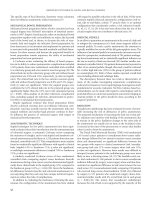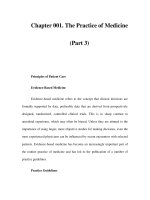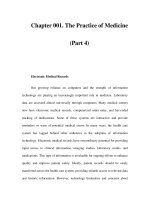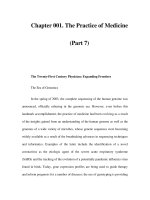Chapter 002. Global Issues in Medicine (Part 8) doc
Bạn đang xem bản rút gọn của tài liệu. Xem và tải ngay bản đầy đủ của tài liệu tại đây (15.5 KB, 5 trang )
Chapter 002. Global Issues in Medicine
(Part 8)
Limited success in scaling-up ITN coverage reflects the inadequately
acknowledged economic barriers that prevent the destitute sick from accessing
critical preventive technologies. Despite proven efficacy and what are considered
"reasonable costs," the 2003 RBM report reveals disappointing levels of ITN
coverage. In 28 African countries surveyed, only 1.3% (range, 0.2–4.9%) of
households owned at least one ITN, and <2% of children slept under an ITN. Why
has the RBM campaign failed to achieve its goals? Do Africans not want to use
bed nets? Do they not recognize malaria as a health risk? Or have project
managers and donors miscalculated most Africans' ability to obtain bed nets?
These are not rhetorical questions. The RBM strategy initially emphasized
the importance of commercial markets as sources of ITNs for African populations.
A precedent supporting this emphasis is the prior existence in countries such as
Madagascar and Mali of local markets for untreated bed nets. Presumably,
therefore, a demand for bed nets existed prior to the RBM campaign, as did a
distribution system with points of sale. However, even with the application of
subsidized social marketing strategies, this market approach has not resulted in
large increases in coverage during the first years of the RBM campaign. Several
studies have attempted to define willingness to pay (WTP) and actual payment for
ITNs in African countries and thereby to determine why market-based strategies
have been unsuccessful. Policy-makers often use WTP figures to determine
appropriate pricing for social marketing projects and to project revenue and
demand. A cross-sectional study in a rural Nigerian community administered two
questionnaires, 1 month apart, to examine community members' WTP for ITNs,
actual purchase of ITNs (with the second questionnaire accompanied by the
opportunity to buy a subsidized ITN), and factors (such as socioeconomic status
and recent history of malarial illness) contributing to hypothetical and actual ITN
purchase. Among the 453 persons answering both surveys, the poorest quintile
perceived a greater risk of malaria than the other quintiles (27.3% vs. 12.9–21.6%,
p < .05). However, the poorest quintile was least likely to own a net, purchase a
net, or express a hypothetical WTP. Even the most well-off quintile was willing to
pay only 51% of the government-set price for an ITN. This finding suggests that
even the relatively well-off may not be willing or able to pay for bed nets at set
prices. The authors of this study concluded that reliance on the sale of nets alone
may prove inadequate and that further studies are needed to define the degrees to
which costs can be lowered and/or demand increased.
A 2002 study in highland Kenya compared the attitudes of people living in
homesteads provided with heavily subsidized ITNs (n = 190) with those of
residents of households that had no ITNs and had not been targeted by other health
care initiatives (n = 200). Of all households, 97% expressed willingness to pay for
ITNs. However, only 4% of those willing to pay offered spontaneously to meet the
suggested price of 350 Kenyan shillings. After being prompted that "nets are
expensive," 26% of respondents expressed willingness to pay the full price. This
study did not offer nets for sale; therefore, the number of nets that would actually
have been purchased is unknown. However, the study did contextualize the
hypothetical WTP for ITNs by comparing their cost with other household costs:
the price of one ITN is equal to the cost of sending three children to primary
school for a year. By placing the nets' relative cost in context, the authors of this
study call into question the likelihood that families in this district, over half of
whom fall below the Kenyan poverty line, would actually be able to purchase
ITNs.
Given the documented barriers to purchasing ITNs, especially among the
poorest of the poor, many researchers and development professionals involved in
malaria programs have called for the free distribution of ITNs, comparing their
importance as a public health measure with that of childhood vaccination. The
adoption of free ITN distribution strategies has been limited, however, by
concerns about their feasibility and potential ITN misuse (for example, as nets for
fishing). Evidence from a targeted free-distribution program discounts both
concerns. In 2001, a Kenyan program sponsored by UNICEF sought to distribute
70,000 ITNs to pregnant women through antenatal clinics. Within 12 weeks,
>50% of the ITNs had reached their intended recipients. A 1-year follow-up
evaluation of 294 women who had received bed nets while pregnant—152 women
from a high-transmission area and 142 from a low-transmission area—revealed
that 84% of women in the high-transmission area used the ITNs throughout
pregnancy. One year later, 77% continued to use the bed nets. In the low-
transmission area, 57% of women used the ITNs during pregnancy, and 46%
continued to use them a year later. These results contradict suppositions that free
nets may not be used because recipients do not value them.
Given the scope and magnitude of the challenge posed by malaria, it is
unlikely that any one strategy will work for every region or population within a
country or across the world. Encouraging results from an employer-based ITN
distribution system in Kenya highlight the potential role of public-private
partnerships. Potential synergies between antimalaria programs and measles
vaccine campaigns or possibly lymphatic filariasis eradication campaigns have
been reported or suggested. Concerns about discomfort associated with sleeping
under ITNs or about insecticide toxicities must be addressed through educational
campaigns.
Meeting the challenge of malaria control will continue to require careful
study of appropriate preventive and therapeutic strategies in the context of our
increasingly sophisticated molecular understanding of the pathogen, vector, and
host. However, an appreciation for the economic and structural devastation
wrought by malaria—like that inflicted by diarrhea, AIDS, and TB—on the most
vulnerable populations should heighten our commitment to the critical analysis of
ways to implement proven strategies for the prevention and treatment of these
diseases.
1
Nuwaha F: The challenge of chloroquine-resistant malaria in sub-Saharan
Africa. Health Policy Plan 16:1, 2001.









